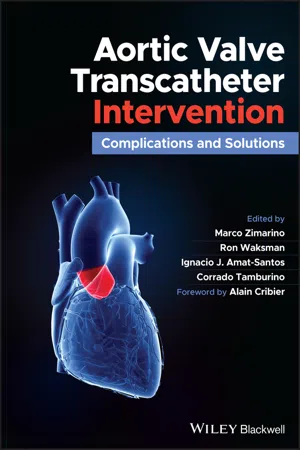
Aortic Valve Transcatheter Intervention
Complications and Solutions
- English
- ePUB (mobile friendly)
- Available on iOS & Android
Aortic Valve Transcatheter Intervention
Complications and Solutions
About this book
Aortic Valve Transcatheter Intervention
Calcific aortic stenosis (AS) is the most common heart valve anomaly, with a largely age-dependent prevalence, a calculated annual incidence rate in the range of 4-5% in general populations and up to 6% in patients aged 75 years and over.
Surgical aortic valve replacement (SAVR) was previously the only option available to patients with symptomatic, severe aortic stenosis. After the first-in-human transcatheter aortic valve implantation (TAVI) was performed by Alain Cribier in 2002, the treatment strategy for patients with symptomatic AS has been revolutionized. Since then, TAVI has grown exponentially, as a result of accruing evidence demonstrating safety and efficacy, and reduced invasiveness compared with SAVR. TAVI devices are continuously expanding to include several valve design options. As this strategy is continuously evolving to treat younger patients and lower-risk populations, aside from the long-term durability of the valve systems, procedural safety will become the focus of newer-generation devices.
This book is a practical handbook devoted to the optimization of TAVI procedures, through a focused containment of complications. Through an integrated evaluation of the clinical status, imaging techniques and laboratory findings, the authors provide readers with clear messages on preventive and therapeutic recommendations.
Frequently asked questions
- Essential is ideal for learners and professionals who enjoy exploring a wide range of subjects. Access the Essential Library with 800,000+ trusted titles and best-sellers across business, personal growth, and the humanities. Includes unlimited reading time and Standard Read Aloud voice.
- Complete: Perfect for advanced learners and researchers needing full, unrestricted access. Unlock 1.4M+ books across hundreds of subjects, including academic and specialized titles. The Complete Plan also includes advanced features like Premium Read Aloud and Research Assistant.
Please note we cannot support devices running on iOS 13 and Android 7 or earlier. Learn more about using the app.
Information
1
Introduction
| Patient profile, as assessed by the Heart Team | ACC/AHA/STS guidelines [12] | ESC/EACTS guidelines [13] |
|---|---|---|
| Severe AS, inoperable | Class I, LOE A | Class I, LOE B |
| Severe AS, high surgical risk | Class I, LOE A | Class I, LOE Bb |
| Severe AS, intermediate surgical riska STS score or Euroscore II ≥ 4% | Class IIa, LOE B | |
| Severe AS, low surgical riska STS score or Euroscore II < 4% | Not recommended SAVR: class I, LOE A | Not recommended SAVR: class I, LOE B |
| Bioprosthetic valve failure | Class IIa, LOE B | Reasonable alternative if the patient is at increased surgical risk |
Table of contents
- Cover
- Table of Contents
- Title Page
- Copyright Page
- List of Contributors
- Foreword
- 1 Introduction
- Part I: General Complications
- Part II: Specific Complications
- Index
- End User License Agreement